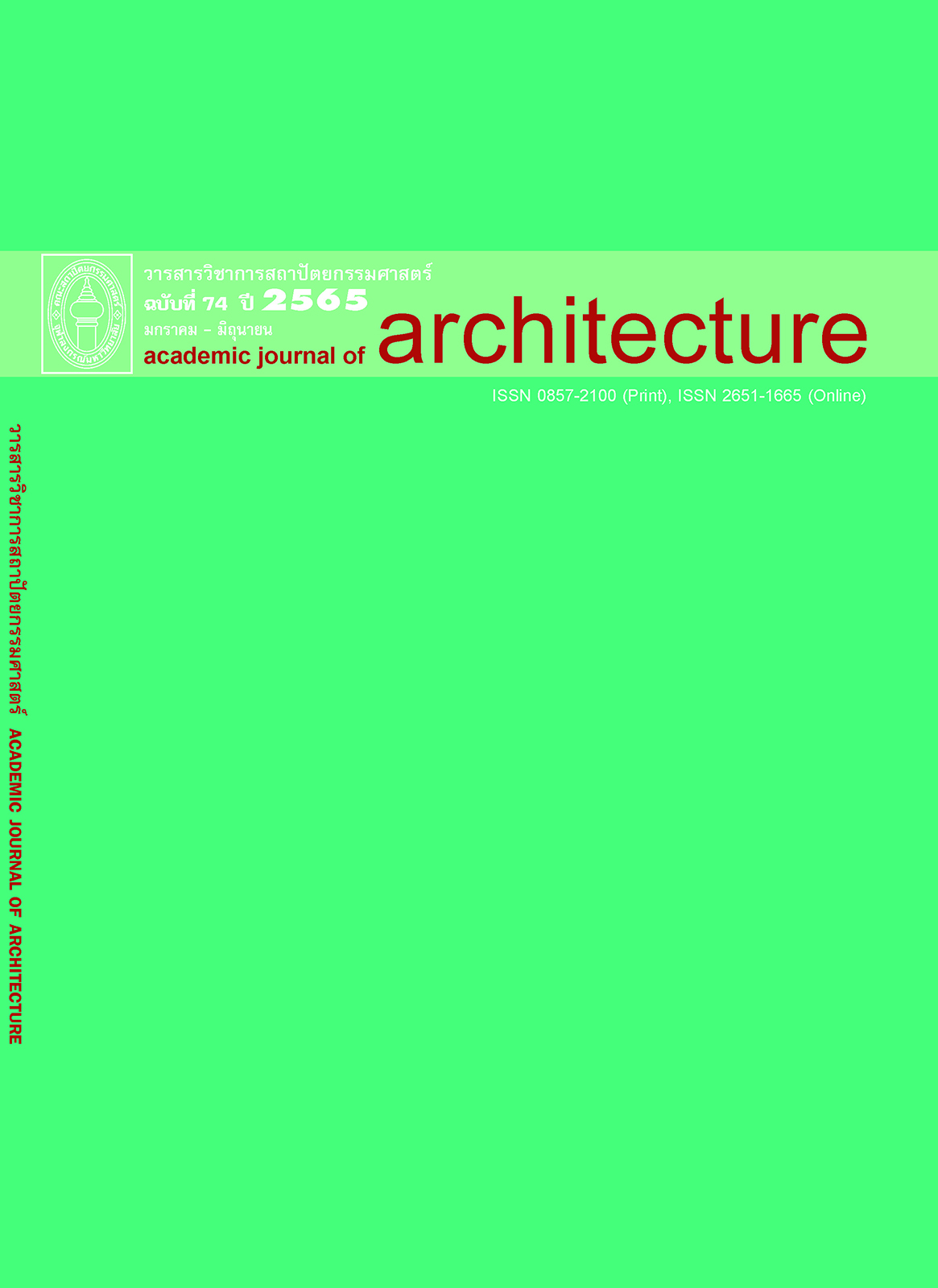Impacts of Building Forms and Light Reflectance of Building Glass Façade on Visual Discomfort of Surroundings
Main Article Content
Abstract
High-rise buildings have been commonly built in Bangkok, Thailand over the last decade. Currently there is the Thai building energy code, which is related to building envelop designs that govern both building façade reflectance and total heat transfer through the exterior envelop or OTTV. Since the code has been developed and recently announced with more intensive regulations, building façade designs with glass envelop have become an important issue. This research attempts to develop a guideline to assess the environmental impact of the reflection of glass buildings on the visual discomfort from glare towards neighboring buildings. The key parameters of the experiment are shapes of building and visible light reflectance of glasses. In this study, five building shapes were defined with various light reflectance, which are 5%, 10%, 15%, 20%, and 27%. These case studies were simulated using Rhinoceros + Grasshopper software to evaluate illuminance level and daylight glare probability (DGP) value. Five thousand four hundred simulation cases were performed. The results showed that if the reflection from the glass building projects directly into the eyes of observers, regardless of the building’s shape and reflectance, the calculated DGPs values were always higher than the imperceptible glare level (DGP < 0.35). To avoid lawsuits between building owners and neighbors after the building construction, the environmental impact assessment should be conducted on a case-by-case basis. The concern cases are buildings with a concave shape design or a tapered tall building with fully covered glass facade and without sun shading devices to reduce reflection. The recommendation is to assess the direction of the reflected light to determine the location of the point that will be severely affected first. Therefore, the DGPs value from that location should be calculated and the impact assessment should be performed in order to find design solution measures. Initial study suggests that the reflection impact be reduced by using solar shading on glass facades.
Article Details
References
ทัชชา อังกนะภัทรขจร และ อรรจน์ เศรษฐบุตร. (2562, กรกฎาคม). แนวทางในการออกแบบเพื่อลดผลกระทบจากการสะท้อนแสงของเปลือกอาคาร. เอกสารประกอบการประชุมวิชาการ BERAC ครั้งที่ 6, คณะสถาปัตยกรรมศาสตร์ มหาวิทยาลัยขอนแก่น. ขอนแก่น: มหาวิทยาลัยขอนแก่น.
มติชนออนไลน์. (2559). ฎีกาชาวบ้าน: ปลูกตึกสูงติดกระจก ระวังต้องจ่ายให้เพื่อนบ้าน!!. สืบค้นเมื่อ 13 กุมภาพันธ์ 2565, จาก https://www.matichon.co.th/matichon-tv/news_157472
สถาบันอาคารเขียวไทย. (2559). คู่มือเกณฑ์การประเมินความยั่งยืนทางพลังงานและสิ่งแวดล้อมไทยสำหรับการก่อสร้างและปรับปรุงโครงการใหม่. กรุงเทพฯ: สถาบันอาคารเขียวไทย.
Bodart, M., & Cauwerts, C. (2017). Assessing daylight luminance values and daylight glare probability in scale models. Building and Environment, 113, 210-219.
Chaloeytoy, K., Ichinose, M., & Chien, S. C. (2020). Determination of the Simplified Daylight Glare Probability (DGPs) criteria for daylit office spaces in Thailand. Buildings, 10, 180. Retrieved from https://doi.org/10.3390/buildings10100180.
Dwyer, C. (2017). Solar glare: Guidelines and best practice for assessing solar glare in the City of London (Planning advice note).London: The City of London.
Hirning, M. B., Isoardi, G. L., Coyne, S., Garcia Hansen, V. R., & Cowling, I. (2015). Post occupancy evaluations relating to discomfort glare: A study of green buildings in Brisbane. Building and Environment, 59, 349-357.
IWBI. (2022). WELL building standard. New York: International WELL Building Institute. Retrieved from https://v2.wellcertified.com/en/wellv2/
Konstantzos, I., Tzempelikos, A., & Chan, Y. C. (2015). Experimental and simulation analysis of daylight glare probability in offices with dynamic window shades. Building and Environment, 87, 244-254.
Mardaljevic, J., Andersen, M., Roy, N., & Christoffersen, J. (2012). Daylighting metrics: Is there a relation between useful daylight illuminance and daylight glare probability? In Proceedings of the 1st Building Simulation and Optimization Conference (pp.10-15). Loughborough: Loughborough University.
Timeless Travel Steps. (2020). What went wrong with the Walkie Talkie Building. Retrieved 2022, February 13, from https://timelesstravelsteps.com/2020/01/29/what-went-wrong-with-the-walkie-talkie-building/
Tyukhova, Y. (2015). Discomfort glare from small, high luminance light sources in outdoor nighttime environments. (Dissertation, University of Nebraska, Lincoln).
USGBC. (2013). LEED version 4 reference guide. Washington, DC: United States Green Building Council.
VELUX. (2020). Guide to daylighting and EN 17037 (White paper). Horsholm: VELUX Commercial.
Wienold, J. (2007). Dynamic simulation of blind control strategies for visual comfort and energy balance analysis. In Proceedings of IBPSA 2007 Conference (pp. 1197-204). Beijing, China.
Wienold, J., & Christoffersen, J. (2006). Evaluation methods and development of a new glare prediction model for daylight environments with the use of CCD cameras. Energy and Buildings, 38(7), 743-757.


